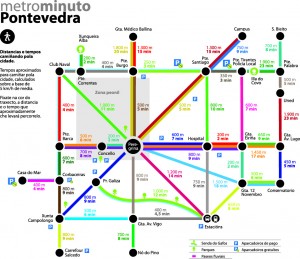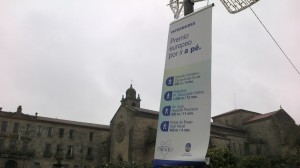by Eduardo Ares
Polis

The city of Pontevedra in northwest Spain has become a leader in walker-friendly urban policy over the past 15 years. In light of its relative anonymity and population of 83,000, one might find it difficult to imagine the traffic congestion that prompted this transformation.
However, as the capital of its province, county and municipality, Pontevedra attracted enough automobile commuters each day to overwhelm its antiquated streets.
Instead of razing old buildings and constructing bigger roads, the city council began taking proactive measures to reduce traffic.
They widened sidewalks, established a free bike-lending service, installed speed bumps and set a speed limit of 30 kilometers per hour throughout the city. They even banned motorized transport in sections of Pontevedra. Walking zones now extend from the historic center to streets and squares in newer neighborhoods.
Although the driving ban initially faced resistance, it is now broadly supported and has become an essential part of the city’s identity as an attractive place to live.

To further improve walkability, Pontevedra’s city council produced a map that visualizes the distances and travel times between key places on foot at an average speed of five kilometers per hour. Known as Metrominuto, the map has color-coded lines that resemble those of a subway guide.
The pink line from Peregrina Square shows that it takes about 14 minutes to walk from there to the train and bus stations. Free parking areas are marked to encourage visitors to leave their cars outside the city center.
According to the map, someone who parks in the free lot near the police station can get to Peregrina Square in less than eight minutes via Santiago Bridge. Metrominuto reminds residents and visitors that many automobile trips can be made in a more convenient, environmentally friendly and healthy way by walking.

The Metrominuto initiative recently won an award from Intermodes, the organizers of an international transport convention for the European Congress, who explained: “Metrominuto is an idea that can be easily transposed in cities that have 80,000 inhabitants (or less), of which there are more in Europe than there are very large conurbations.”
Pontevedra’s urban restructuring program has also earned accolades from the Spanish Committee of Representatives of Persons with Disabilities and the Spanish Directorate General of Traffic.
Pontevedra’s walker-oriented initiatives raise questions as to how they came into being and how they’ve influenced living conditions in the city. Researching these questions should tell us whether Intermodes’ recommendation is warranted, offering insights into the potential for similar initiatives in other cities around the world.
Eduardo Ares is a doctoral candidate in computer science at the University of A Coruña in Galicia, Spain.




